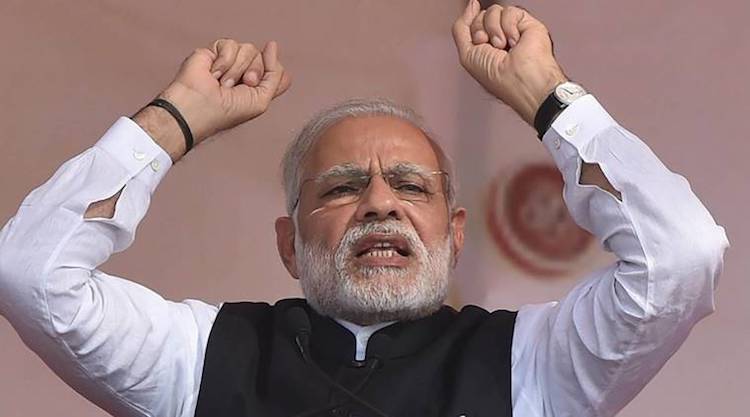Viewpoint by Jonathan Power*
LUND, Sweden (IDN-INPS) – Recent reports estimate that India’s annual economic growth rate is now down to 5.5%. The government of Narendra Modi which until recently seemed to be on a public opinion roll could fall off its log – but that depends on the Indian electorate ending its self-deceit.
Three years ago Modi at the helm of his Hindu nationalist party, the BJP, gave Congress a thumping defeat. Suave and persuasive on the podium, Modi rammed home a simple message that in the state of Gujarat where he was the chief minister more had been achieved in a short space of time than anywhere else in India. It was industrializing fast, building more roads, modernizing its ports and communications and helping the poor.
There was some element of truth in this and few doubt that Modi is an effective administrator who is strong on productivity and hard on corruption. Nevertheless, when it comes to the poor the record is by no means as good as he preached. Hunger in his state only fell slowly, no faster than the Indian average. Two-thirds of Indian children received vaccinations but only half in Gujarat. 33% of its children were underweight whilst the Indian overall rate was 30%.
Modi with his silken songs of achievement put the Congress Party in the shadow. Never mind that the Congress government of Prime Minister Manmohan Singh and party chairwoman Sonia Gandhi had reduced the number of poor by 135 million, the poor gravitated towards Modi.
Congress seemed unable to persuade the media – and this was true of the international media too – to give it a fair hearing on its successes. Yes, the government presided over a society where corruption seemed to worsen and the loosening up of import controls and the regulations on foreign ownership seemed to go at a snail’s pace but its achievements were often magnificent. At one point, economic growth touched 10% before falling back (a fact that I saw only once reported). In its second term of office it was often over 8%. It jumped ahead as China was slowing down.
India made great inroads on poverty although it has to be said that its neighbour, Bangladesh, once the basket case of Asia, does better.
Among Singh’s accomplishments was his introduction of a guaranteed 100 days of work for the unemployed. They were sent to build dams, roads and dig wells. He introduced the right to subsidized food to cover some two-thirds of the country’s population. There was the right to a free lunch at school. All children were promised a place in school. Farmers got access to cheap supplies of fertilizer and petrol. Not all these projects went as well as they could – graft, poor workmanship and maladministration took their toll and teachers were often of low quality. Nevertheless, to be poor in 2014 was not like being poor in 2004.
Singh’s great idea was to introduce biometric ID’s to everyone in India. Government subsidies, instead of being routed through a corrupted bureaucracy, go straight to the bank account of the peasant or proletarian.
Singh was active in foreign affairs and won from the Americans an important agreement that opened up India’s need to import uranium. He enabled the sophisticated parts of the economy to do well. But below that level there was not much growth in employment among the working class. Agriculture was not taken as seriously as was needed since that sector employs more poor people than any other.
Adding it up there were far more pluses and less negatives under Singh than there were to be under Modi. Indeed there would have been far more pluses if the BJP had not blocked important reforms in parliament. The poor were helped like never before but they, as well as a majority of the middle and upper class who had also done well, turned towards Modi when election time arrived three years ago.
Luck favoured the new prime minister. Oil prices fell dramatically and cut India’s import bill by a large amount. This gave the economy a bounce and the growth rate returned to an upswing following a couple of years of low growth at the end of Congress’s time in office. In 2016 Modi pushed through legislation to create a single market across the country, which will aid growth in the long run.
For now the growth rate has turned down. Things are suddenly not looking good for Modi. Too much banking and company debt have been ratcheted up. And then there is Modi’s tolerance of Hindu anti-Muslim agitation. This doesn’t give India a positive image overseas, which contributes to the fall in foreign investment and deters highly successful expatriate Indians returning from Silicon Valley and Cambridge.
The poor in the Indian electorate should wake up. The evidence is now in. Without much doubt Congress served them better. [IDN-INPS – 3 October 2017]
*Note: For 17 years Jonathan Power was a foreign affairs columnist and commentator for the International Herald Tribune – and a member of the Independent Commission on Disarmament, chaired by the prime minister of Sweden, Olof Palme. He is the author of a newly published book, “Ending War Crimes, Chasing the War Criminals” (Nijoff). He also authored “Like Water on Stone – the History of Amnesty International” (Penguin). He forwarded this and his previous Viewpoints for publication in IDN-INPS. Copyright: Jonathan Power.
Photo: In last six quarters, the economy under Prime Minister Modi sank from 9.2 per cent to 5.7 per cent, according to the Congress Party. Courtesy: PTI.
IDN is flagship agency of the International Press Syndicate.
facebook.com/IDN.GoingDeeper – twitter.com/InDepthNews

